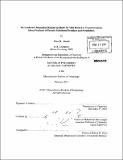Stereoselective monoalkyl diazene synthesis for mild reductive transformations : direct synthesis of densely substituted pyridines and pyrimidines
Author(s)
Ahmad, Omar K. (Omar Khaled)
DownloadFull printable version (14.22Mb)
Alternative title
Direct synthesis of densely substituted pyridines and pyrimidines
Other Contributors
Massachusetts Institute of Technology. Dept. of Chemistry.
Advisor
Mohammad Movassaghi.
Terms of use
Metadata
Show full item recordAbstract
I. N-Isopropylidene-N'-2-Nitrobenzenesulfonyl Hydrazine. A Reagent for Reduction of Alcohols via the Corresponding Monoalkyl Diazenes The development of a new reagent N-isopropylidene-N'-2-nitrobenzenesulfonyl hydrazine (IPNBSH) is described. IPNBSH is used in the reduction of alcohols via the loss of dinitrogen from transiently formed monoalkyl diazene intermediates that can be accessed by sequential Mitsunobu displacement, hydrolysis, and fragmentation under mild reaction conditions. II. Stereospecific Palladium-Catalyzed Route to Monoalkyl Diazenes for Mild Allylic Reduction The first single-step stereospecific transition metal-catalyzed conversion of allylic electrophiles into monoalkyl diazenes is described. This synthesis of allylic monoalkyl diazenes offers a new strategy for asymmetric synthesis by the reduction of optically active substrates or the use of chiral catalyst systems for the reduction of racemic and prochiral substrates. Sensitive substrates are reduced in a highly selective manner. III. Direct Synthesis of Pyridine Derivatives A single-step conversion of various N-vinyl and N-aryl amides to the corresponding pyridine and quinoline derivatives, respectively, is described. The process involves amide activation with trifluoromethanesulfonic anhydride in the presence of 2-chloropyridine followed by n-nucleophile addition to the activated intermediate and annulation. IV. Synthesis of Densely Substituted Pyrimidine Derivatives The direct condensation of cyanic acid derivatives with N-vinyl and N-aryl amides to afford the corresponding C4-heteroatom substituted pyrimidines is described. The use of cyanic bromide and thiocyanatomethane in this chemistry provides versatile azaheterocycles poised for further derivatization. The synthesis of a variety of previously inaccessible C2- and C4- pyrimidine derivatives using this methodology is noteworthy.
Description
Thesis (Ph. D.)--Massachusetts Institute of Technology, Dept. of Chemistry, 2011. Vita. Cataloged from PDF version of thesis. Includes bibliographical references.
Date issued
2011Department
Massachusetts Institute of Technology. Department of ChemistryPublisher
Massachusetts Institute of Technology
Keywords
Chemistry.